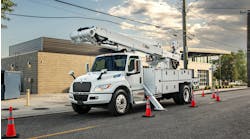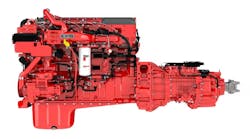A couple years ago, I found myself on a Meritor test track in Wales, U.K. evaluating new commercial vehicle safety systems. Trips to Europe are always enlightening from a technology standpoint, since so many new safety and drivetrain systems originate there. But on this day, I was struck by something a bit more Old School: The manual gearboxes in a couple of the European cabovers we were driving that day. These were fully-synchronized transmissions, as smooth and easy to operate as shifting a Honda or a Toyota passenger car. The entire experience was actually a little bit surreal: driving a Class 8 tractor with a dinky little, dash-mounted shifter with absolutely no worries about engine RPMs or double-clutching. Naturally, I starting asking around about these odd gearboxes and was surprised to discover that they're pretty common in Europe. They've also made massive inroads in China, which is basically building its trucking/logistics industry and network from scratch and has no preconceived notions as to how a truck drivetrain should be operated. A buddy who works at another European vehicle component supplier told me his company tried to bring synchronized gearboxes to the States a decade or so ago, only to have them flop in the marketplace. Why was that? I asked him. They were so much easier and safer to drive than unsynchronized transmissions. He just shrugged his shoulders. "They're not macho enough for American drivers, I guess," he replied. If you're the type of Old School Gear Jammer who sneers at synchronized manual truck transmissions, you gaze in horror at modern Automated Manual Transmissions. Yet, here they are, gaining marketshare at a breath-taking rate and utterly transforming how trucks perform today. But what about manual transmissions? Are they destined for the technological dust bin? Are we just a few years away from logging onto YouHologram (or however we'll be watching videos in the future) to chuckle at the memories as some guy demonstrates who to shift between low and high range on a 13-speed gearbox? My thoughts are that AMTs are well on their way to becoming the dominate transmission in both medium- and heavy-duty trucking and will likely reach full-market penetration on new vehicles before this decade is out. But that doesn't mean there won't be a place for manual gearboxes in trucking. But I suspect their roles will evolve toward more specialized niches such as severe-duty, extreme heavy-haul and off-road and severe-terrain conditions. And, of course, there are always going to be drivers -- young and old alike -- who prefer a manual gearbox for a variety of reasons. When asked, manual gearbox adherents usually tell me they simply feel more in control of a truck when they're shifting gears, as opposed to a computer doing it for them. So there are always going to be drivers out there who prefer shifting the old--fashioned way. But my suspicion is that trucking as an industry has made a sea change: In the past, trucking focused on delivering the goods on time, no matter what. Trucks and powertrains were designed with that emphasis foremost in mind. Poor fuel economy was simply a means to an end. Today, it is clear that the focus has shifted. Delivering goods is just as important as it's ever been. Perhaps even more important, if that's possible. But truck and powertrain design is rapidly shifting toward optimal fuel economy as its priority. It's not enough to get the good there on time, anymore. You've got to do it as fuel efficiently as possible, too. Beginning next year, I think we'll see the first concrete evidence of a new philosophy in trucking: The first generation of truck models with fully integrated fuel economy designs. Every aspect of vehicle design will be engineered with fuel economy as a priority. Moreover, every aspect of vehicle design will be engineering to compliment every other aspect of the design. Simply put, the truck's overall shape and aerodynamic profile will be designed to complement and boost the performance of its drivetrain in every possible way, and vice-versa. And I hate to be the one to tell you, but there's not going to be much room for manual transmissions in those highly integrated and sophisticated truck designs of the near future.

Voice your opinion!
Voice your opinion!
To join the conversation, and become an exclusive member of FleetOwner, create an account today!
Latest from Powertrain
Latest from Powertrain


